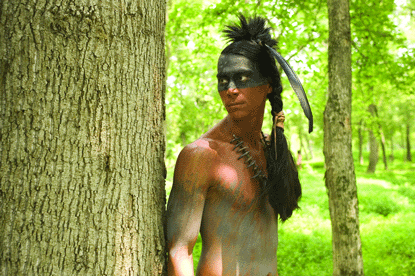A visionary auteur’s inspired rendition of an American creation myth
As is well known, Terrence Malick’s transit from MIT professor to New Hollywood wunderkind to recondite philosopher king is one of the most distinctive careers in the whole American cinema. Seven years on from his brilliant, uneven “The Thin Red Line,” it retrospectively appears a threshold Malick had to cross out of his preceding 20-year-long self-willed seclusion.
His latest feature, “The New World,” returns to one of the first frontiers of American lore—the settling of Jamestown by English colonists in 1607, and their encounter and clash with the Powhatan confederation in whose backyard they landed. The film turns on the relationships between the princess Matoaka—known to eternity by her nickname Pocahontas, and incarnated here by the radiant Peruvian-born ingénue Q’orianka Kilcher—and two Englishmen, the roguish adventurer John Smith (Colin Farrell) and the wellborn tobacco planter John Rolfe (Christian Bale).
“The New World” engages with, and operates in, the realm of fable and archetype. Many historically contested or disproved matters—most crucially the spurious romance between Pocahontas and John Smith—are fused into a spellbinding fiction garlanded with Malick’s signature poetic voice-over narration. As ever, he follows his own program, reshaping canonical myths rather than demystifying them with naked fact—as in how Pocahontas first appeared to Smith and the English, whereas the film veils her purity in the most scrupulously researched buckskins.
Malick’s production is of course the most recent in a long line of film variations on Pocahontas, stretching from an Edison Studios silent of 1908 to Disney’s 1995 animated version starring a bronzed, buxom supermodel. Even Malick’s vaunted attention to historical detail—the official press notes are a litany of painstakingly replicated locations, sets, and costumes—has cinematic precedents. “The Mended Lute,” a D.W. Griffith one-reeler from 1909 on which the early Native American filmmaker James Young Deer served as technical advisor, was hailed in its day for “expert details.”
A similar discourse of authenticity is mobilized by “The New World,” which seeks to distance itself from the schlocky distortions of Hollywood history and simultaneously to close the four-century wide experiential gap through an intensified haptic fidelity.
In Malick’s dreaming, the English who sailed into the Chesapeake littoral in 1607 were a pious and fearful band, their gaze fixed on the tall tidewater grasses and the outermost edge of that dark primeval forest which then extended unbroken to the Mississippi. Their disembarkation and landfall are scrutinized from afar and then met by “the naturals,” as the English call them, who receive the strangers with lively curiosity, sniffing at the pale men’s torsos and tapping warily at their armor. Malick evokes well the profound disorientation and barely suppressed panic of the great before-and-after moment.
Under the sure hand of fleet commander Captain Newport (Christopher Plummer), the foundations of James Fort are swiftly laid, and Smith, who sailed in the stocks for misbehaving, is deputized on probation to lead food-gathering expeditions. By this time, he’s already turned the head of Pocahontas, drawn as much by his natural leadership aura as by his molten irises and rippling physique. Smith proves the only survivor of an ambushed venture up the Chickahominy River. Brought to the Powhatan chief Wahunsunacock (August Schellenberg), he is bound to a rock and, seemingly, about to be clubbed to bits when Pocahontas, in Smith’s own words, “got his head in her armes, and laid her owne upon his to save him from death.”
Smith thereupon dances around bonfires with the warriors, learns Algonquian while teaching Pocahontas the King’s English, and in sum pulls off that crafty ole white folks’ trick of becoming more native than the natives themselves. Reluctantly returning to the fort, Smith discovers, conversely, the exponents of European civilization devolved to a state far more savage than the “savages.” The 38 surviving colonists, of the original 103, are a ghastly lot of emaciated, disease-blighted adults and feral urchins in a sodden mud pit, a hair’s breadth away from cannibalism and utter chaos.
As he forewarns her he will, Smith repays Pocahontas’ love with betrayal. After she has shared a precious crop seed with the invaders—for which her father disowns her—and alerted them to impending attack, all out of devotion to Smith, he retreats to England and has the colonists tell her he has died. Inconsolable, Pocahontas is held hostage by the English as insurance against Powhatan attacks, presented more as a benign adoption in the film. During her captivity she meets the second-wave colonist Rolfe, played with welcome restraint by the never more aptly named Christian Bale.
Malick is said to have instructed New Line executives of Pocahontas, “This is our original mother,” an archetype that calls to mind critic Leslie Fiedler’s observation, “The huge warm enveloping darkness of unconscious life, the blind source of passion and reproduction and death, takes form as the triple goddess.” This triple deity could be mapped across the three phases of Pocahontas’ life as told by the conquerors––embodiment of the virgin continent’s irrepressible fecundity, pagan protectress of James Fort, and the converted Christian “Rebecca Rolfe” presented to British royals shortly before her death. The real-life Mrs. Malick cameos as Queen Anne.
In a very literal sense, Pocahontas indeed “mothered” the colonists with regular deliveries of food throughout their first winter, without which they would have followed their forerunners at Roanoke into oblivion. Malick condenses these lifesaving envoys into one sequence of the solemn, fur-enshrouded princess leading a contingent stooped with supplies through a twilit snowfall, past the defenseless gates of the wretched fort. Moreover, her marriage to Rolfe yielded not only their son Thomas but the six-year long “peace of Pocahontas” which incubated James Fort into James Towne.
Matoaka herself, however, stays bonded to quite another maternal force. When she prays, “Mother… you are my strength when I have none,” I don’t believe she’s literally addressing one of the chief’s numerous wives. In the film’s overture—rapturous widescreen images of water, wind, and forest lensed by Emmanuel Lubezki—we can perhaps discern the earth’s own perspective, a sentience preceding even the Indians’ arrival. Later, when Rebecca Rolfe is paraded through London, we viscerally feel the strangeness of the place through her awed apprehension of unruly nature totally domesticated in England’s geometric gardens.
In Malick’s essentially pluralist conception, the original mother achieves the American miracle of upward mobility by becoming the first truly modern citizen of the a-borneing nation, a knockout hybrid of brown and (studied) white, old and new, the ark of the future fashioned from sturdy homegrown materials. Yet while Malick’s vision is exalted, “The New World” is no triumphalist apology. The fathomless anguish of the Indian genocide haunts every scene, if somewhat too subtly. Notwithstanding several pitched combat sequences, tauter and more gripping than in “The Thin Red Line,” the film scarcely admits of rage.
Malick’s mythopoeia is finally poised between the stillborn promise of the new nation, unfulfilled precisely to the degree that its original sins remain unresolved and wished away, and an impulse toward the more all-encompassing regeneration hinted at by poet Simon Ortiz in “From Sand Creek:”
That dream
shall have a name
after all,
and it will not be vengeful
but wealthy with love
and compassion
and knowledge.
And it will rise
in this heart
which is our America.
gaycitynews.com


































